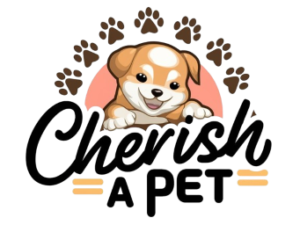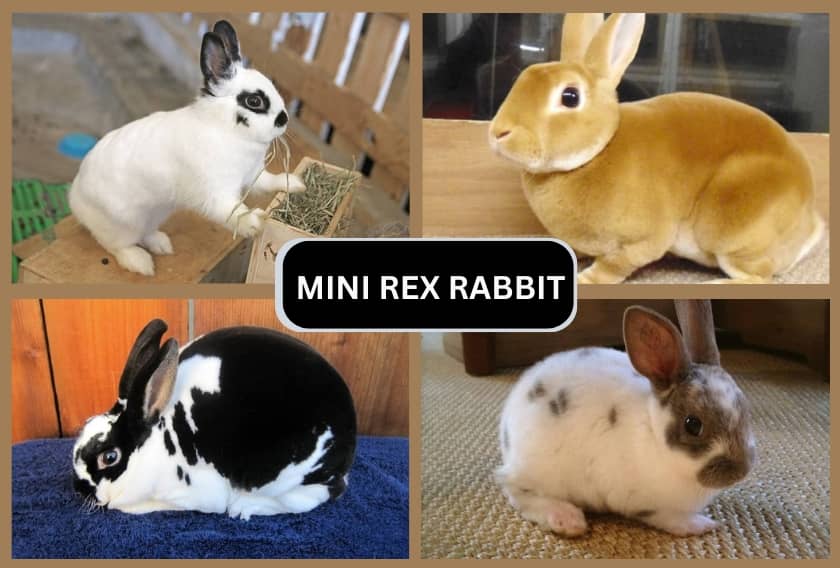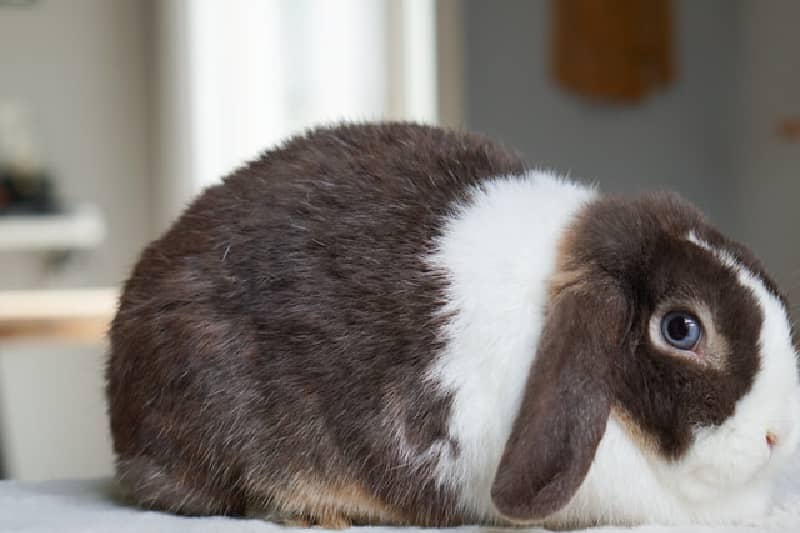The Mini Lop rabbits are a popular breed among domestic rabbits due to their compact size, friendly nature, and distinctive floppy ears. Due to their round shaped body, Mini Lops are often called a “basketball with a head”

The development of Mini Lop rabbits is an interesting story that involves crossbreeding and selective breeding practices to achieve the small, lovable breed we know today. The Mini Lop breed originated in Germany, where it was known as the “Klein Widder”. Upon arriving in the U.S., the breed was renamed to Mini Lop by breeders who continued to refine its characteristics.
The breed was refined through selective breeding, emphasizing the compact, muscular body, broad head, droopy ears, and soft, dense fur. They are a smaller version of the larger Lop breeds, characterized by their distinctive floppy ears and rounded bodies.
In 1980, the Mini Lop was officially recognized by the American Rabbit Breeders Association (ARBA).
Size and Life Expectancy
Mini lops are small in size but they are larger than holland lops. Mini lops typically weigh between 4.5 to 6.5 pounds (2 to 3 kg).
They have a compact, muscular body with a broad head and a short neck. Their fur is dense, soft, and medium in length, coming in a variety of colors and patterns such as Lynx, opal, Black, White, Ruby Eyed White, Blue Eyed White, Blue, chocolate, and lilac.
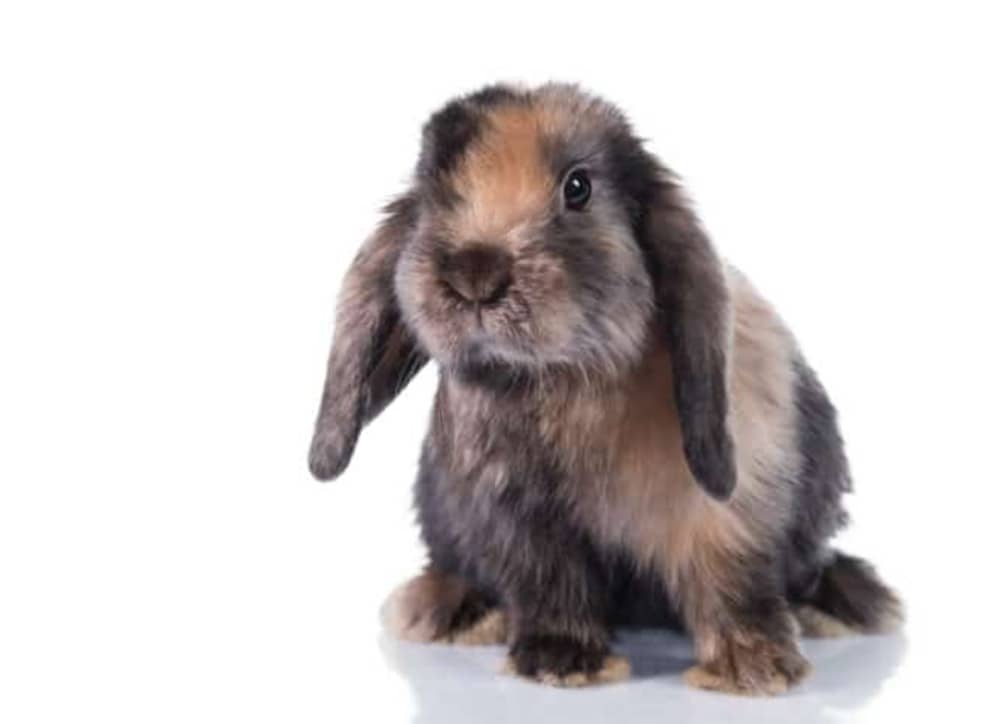
They have large, floppy ears that hang down the sides of their heads. The life expectancy of Mini Lop is around 8-10 years.
Behavior and Temperament
Mini Lops are outgoing and amiable creatures. They can be very affectionate and frequently like interacting with people. They are a pleasure to connect with daily since they are inquisitive and lively and develop close relationships with their owners. If introduced to other pets in the right way, they can form strong bonds with their owners as well.
Because of their gentle disposition and tolerance for small hands, mini-lops are perfect for households with young children. They are a good choice for homes with limited space because they take up less room than larger kinds of rabbits due to their small size.
Mini Lops love games, toys, and spending time outside their cage for exercise. They are lively and playful animals.
How to Care For the Pet Mini Lop Rabbit?
The Mini Lop rabbits are delightful creatures that bring joy and companionship. Ensuring their optimal health and happiness requires a dedicated approach to their care. It includes a spacious cage or hutch, a nutritious diet, and regular veterinary checkups.
Housing
Mini Lops require a spacious cage or hutch, ideally with a minimum of 4 square feet of space per rabbit. The general rule says that the size of the house should be nearly four times the size of rabbit. They should also have daily access to a larger, rabbit-proofed area for exercise. Indoor housing is preferable to protect them from predators and extreme weather conditions.
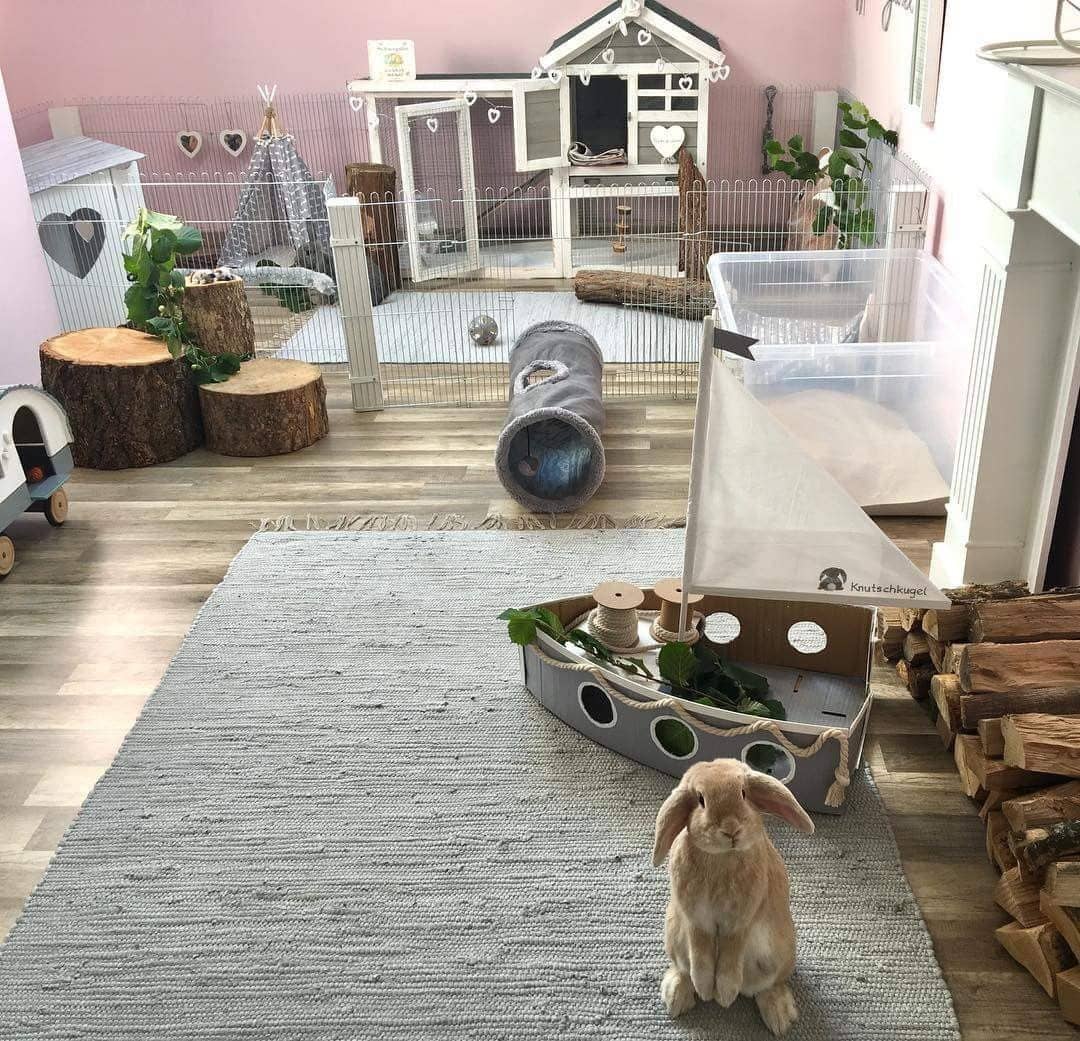
Specific substrate Requirement
The substrate in the cage should be comfortable and absorbent. Common substrates include hay or straw which is soft and edible, paper base bedding, or wood shavings. You should avoid cedar or pine as they can be harmful to rabbits.
Food Bowl
Their diet should consist mainly of high-quality hay, fresh vegetables, and a small amount of pellets to provide essential nutrients.
Water bottle
You should provide clean and fresh water to your rabbit in a water bottle.
Chew Toys
Rabbits have chewing instincts that should be satiated by providing chew blocks, mineral blocks, and hay balls.
Litter Box
A litter box can be placed near to its enclosure. It should be filled with hay or any other non-dusty material so that your rabbit does not catch any respiratory disorder. You can train Mini Lop rabbit by giving it a treat whenever it uses the litter box.
What does a Mini Lop Eats and Drink?
Hay should be the prime component of your rabbit’s diet. It can be Timothy hay, orchard hay or grass hay. Vegetables like celery leaves, carrot tops, parsley, arugula, romaine, butter lettuce, and green and red leaf lettuce will provide your bunny with enough fiber.
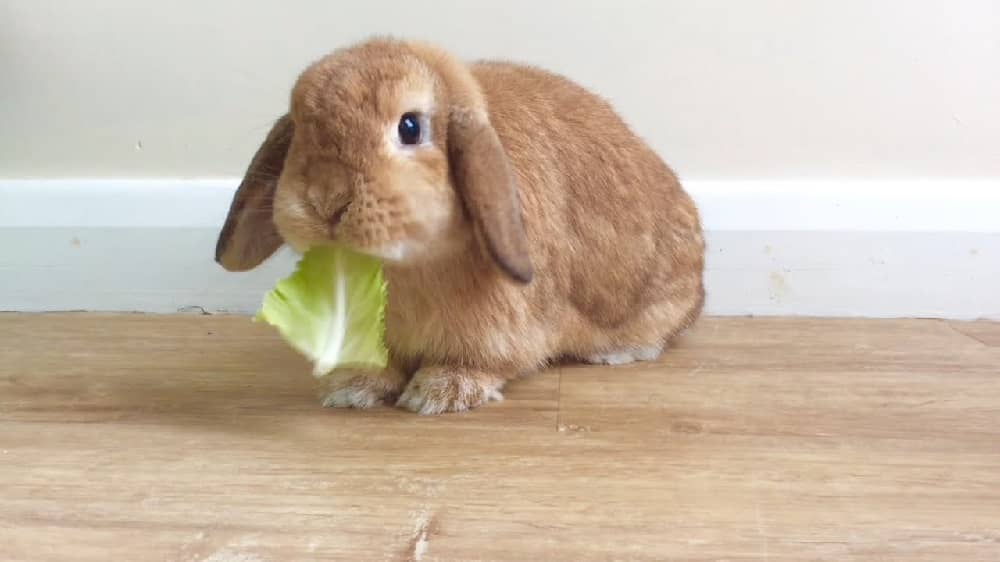
You can also give certain fruits such as apples, pears, and bananas as an occasional treat. Additionally, pelleted food for rabbits should be given in moderate amounts. An adult Mini Lop can be given 1/4 to 1/2 cup of pellets per day.

Your bunny should have access to clean water. You should avoid keeping water in a dish as it may lead to bacterial growth. The use of water bottles is a good alternative and you should daily change the water, clear the nozzle, and check for any blockages.
Exercise
Mini Lops need ample room to move around, so opt for a large cage or exercise pen filled with soft bedding, hides, and toys. Be sure to place the enclosure in a quiet, low-traffic area of your home. Mini Lops are active and need plenty of exercise to stay healthy. Interactive toys and tunnels can provide mental and physical stimulation They should have at least 3-4 hours of supervised playtime outside their cage daily.
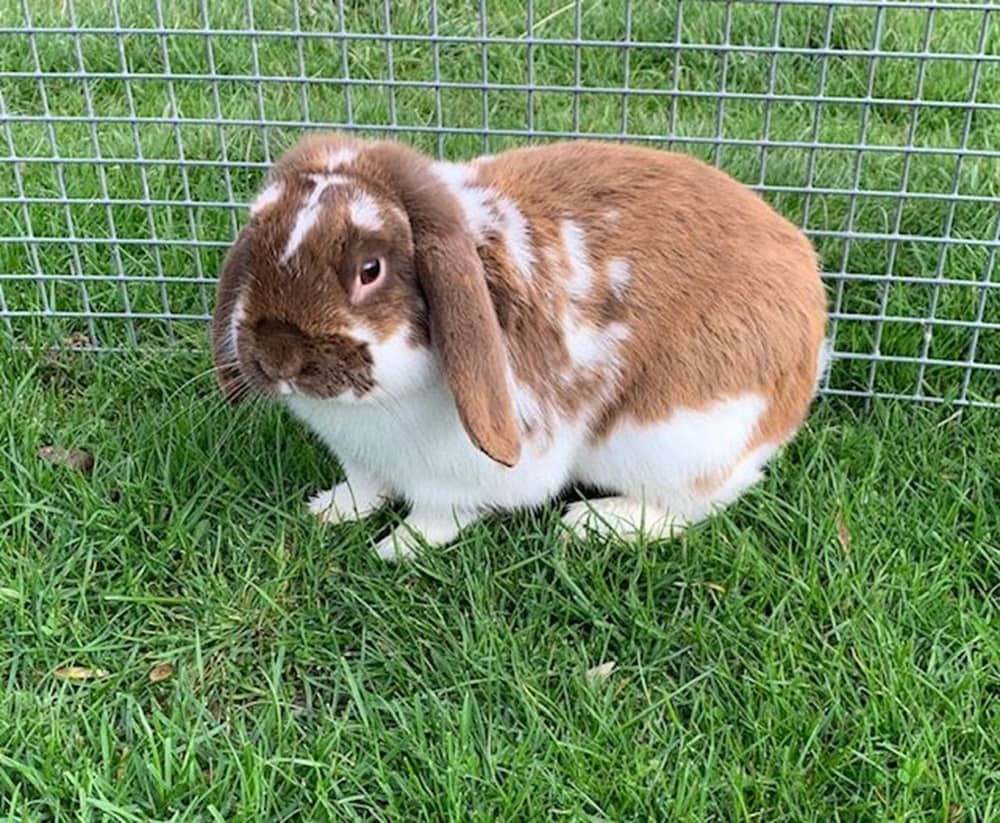
First and foremost, rabbit-proof your living area. Mini Lops are notorious chewers, so you’ll want to cover or remove any electrical cords, furniture legs, and baseboards that could become targets. Provide plenty of safe, appropriate chew toys to satisfy their instinct to gnaw.
Handling of your Mini Lop
It’s important to approach mini-lop rabbits calmly to prevent them from being startled. To safely lift them, place one hand beneath their chest and the other under their hindquarters. To support them and stop them from escaping, hold them close to your body. One should never pick them up by their scruff or ears, as this might injure and stress them. You should frequently pick your Mini Lop rabbit from the beginning. However, you should always be kind and patient. Put them down safely and try again later if they struggle or make noises, which are symptoms of distress.
Common Health Problems In Mini Lop
Mini Lops are the Pugs of the Rabbit World with a host of head-shape-related health issues.
Ear Problems
The Mini lops have floppy ears that typically reach below their chin and close to their cheeks. They are prone to bacterial infections and mites. You can regularly clean the ears with a Rabbit-friendly ear cleaner after consulting your vet. Moreover, check the base of the rabbit ear for signs of swelling, dirt collection, or pus formation. They may have developed ear abscesses.
Upper Respiratory Infection
As rabbits have a delicate respiratory system, all breeds show URI. You can reduce the risk by keeping its habitat clean and choosing a dust-free litter material.
Dental Problems
All rabbit breeds have overgrown teeth that need to be sheared by providing enough chewing material in their diet. The misalignment of teeth also causes problems in chewing. Mini Lop rabbits with dental issues may paw at their faces, slobber excessively, eat less, and occasionally get ulcers or swellings along their jaws.
Mini Lop have a short and boxy skull and teeth can grow uneven and affect their eyes and tear ducts. As a result, they can have “weepy eyes”.
A proper diet with chew toys and regular check-ups can limit dental problems.
Gastrointestinal Stasis
In this condition, the passage of food from the digestive tract slows down. It is a serious and life-threatening condition and your rabbit needs immediate veterinary treatment. The condition arises due to stress, pain, illness, or poor diet. You can avoid this condition by providing a nutritious diet and maintaining a exercise schedule to keep your furry friend metabolically sound.
Hair Ball obstruction
Rabbits are cleaner creatures and while grooming themselves they tend to ingest hair. Unlike cats, rabbits cannot vomit and eventually develop hairball obstruction in their digestive tract.
With daily brushing, you can reduce the chances of developing Hair Ball Obstructions.
Sign of ill health
If you observe changes in behavior, droppings, eating patterns of your rabbit, you need to act accordingly. Furthermore, you should consult a veterinarian timely to provide needed care.
Lethargy: A normally energetic rabbit that exhibits signs of illness may be sick.
Loss of Appetite: Refusing to consume food or liquids may be a sign of a medical issue.
Changes in Droppings: Abnormal droppings may indicate gastrointestinal problems.
Respiratory Problems: Nasal discharge, wheezing, or sneezing may be signs of respiratory infections.
Paw changes: Wiping the nose is indicated if the paws are not yellow and crusty.
Ears: If your bunny is constantly picking at his ears, this could be a sign of bacterial development and wax buildup.
Pros and Cons of Keeping a Mini Lop as a pet
Pros
Social: Enjoy interacting with people and make wonderful companions.
Adorable: They are available in various colors, solid and broken markings.
Manageable Size: They are Compact and therefore it is simpler to work with.
Playful: Energetic, curious, and loves to play with children and other pets.
Trainable Litter: The Mini lops can be litter -trained with consistent efforts.
Long Lifespan: With the right treatment, can live a long, healthy life.
Cons
High Maintenance: Needs constant upkeep and grooming.
Health Issues: The Mini Lops are prone to medical issues.
Time-consuming: Require social interaction and regular exercise.
Sensitive: May be hesitant and need careful treatment.
Diet-specific: Require strict food intake monitoring and a balanced diet.
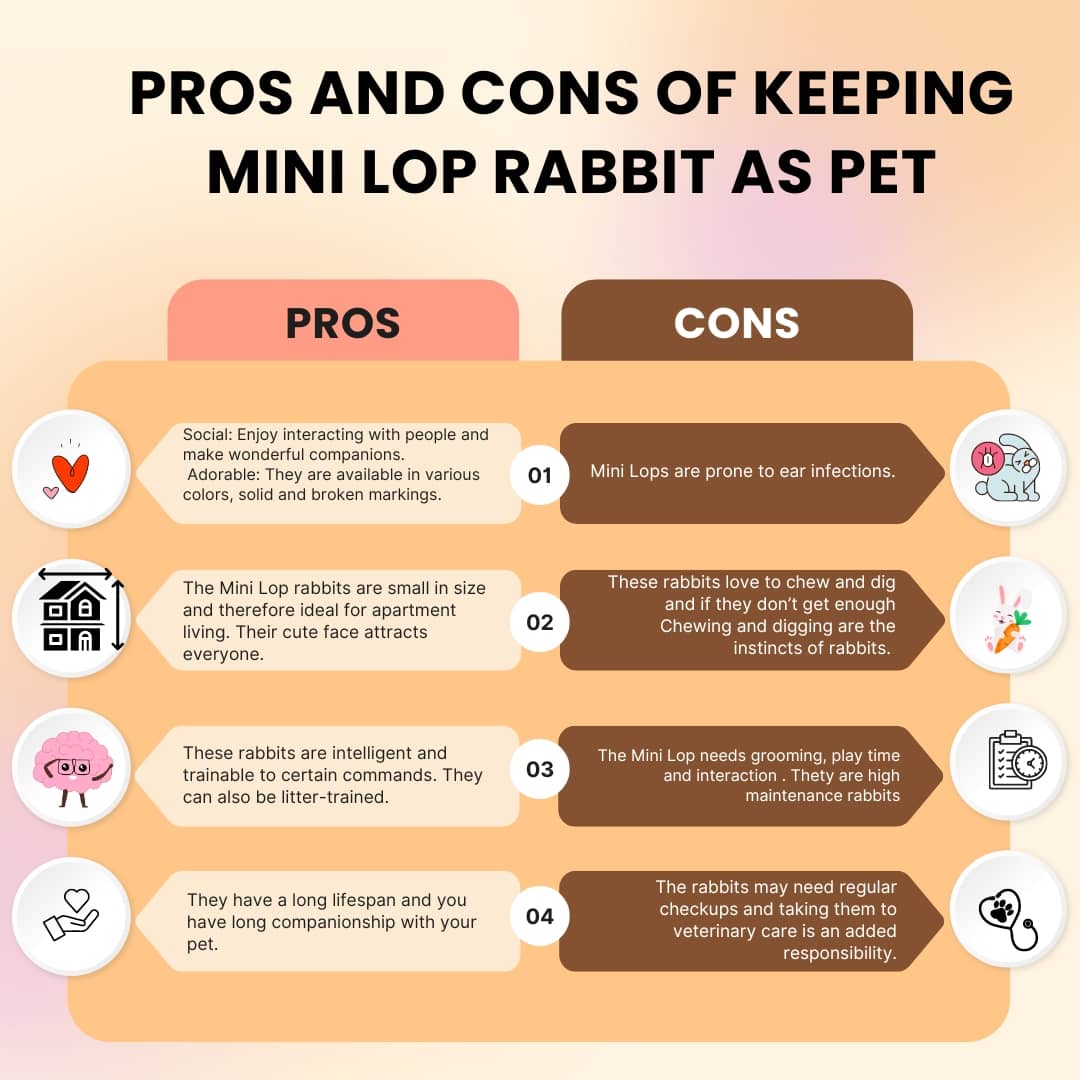
Where to Buy
Mini Lops can be purchased from reputable breeders through various online marketplaces such as Lovely Bunny. The local pet stores can also provide healthy Mini lop. You can also check some rabbit rescue centers that provide rabbits for adoption.

You can get your mini lop in the range between $50- $200. The initial setup cost for enclosure and other supplies can be higher, based on what you can source easily from home.
Upkeep Cost
The upkeep cost for a Mini Lop can range from $500 to $1000 annually. It will cover food supplies, grooming Kits, bedding, chew toys, and veterinary care. Moreover, you need to spend for maintaining litter box and other worn out things in its enclosure.
Grooming
Regular grooming is essential to prevent matting and hair ingestion. You will have to spare time to brush your Mini Lop weekly, more often during shedding seasons. Mini Lops require Nail trimming after 3-4 weeks.
Reproduction and Mini Lop Breeding
Breeding Mini Lops requires careful planning and understanding of rabbit genetics. Mini lops sexually mature approximately at 5 months. The gestation period is around 30-31 days. Female rabbits can have multiple litters per year, but responsible breeding practices are crucial to ensure the health of both the doe and the kits.
Related Species
Several different breeds have resulted into Mini Lop Rabbits. These are Dwarf Lop, Polish Lop, English Lop, French lop and Chinchilla.
- English Lop
- French Lop
- Holland Lop
- Chinchilla
Interesting Facts about Mini Lops
- Mini Lops were originally called “Klein Widder” in Germany.
- They were officially recognized by the ARBA in 1980.
- One Mini Lop Breed Club called the breed “Monarch of the Fancy” and others “Lop of Excellence”.
- They come in a variety of colors and patterns.
- Their lifespan is typically 8-10 years but they can live longer with proper care.
- They have powerful hind legs and can jump impressively high.
- Mini Lops can be trained to use a litter box.
- They have a sweet tooth and love occasional fruit treats.
- They require more grooming than some other breeds due to their dense fur.
- Mini Lops are popular in rabbit shows for their cute appearance and gentle temperament.
- Mini Lops are playful and with affectionate nature
- Mini Lop need much time outside their cage for their physical and mental stimulation.
Frequently Asked Questions
Question 1. Do Mini Lop rabbits make good pets for children?
Answer: Yes, Mini Lop rabbits are friendly, cute, and playful creatures, and keeping them as pets is quite rewarding.
Question 2. What are the common health issues in Mini Lop rabbits?
Answer:. Ear Abscesses, dental problems, and respiratory infections are some of the common health concerns in Mini Lop rabbits.
Question 3. Can Mini Lop rabbits be litter-trained?
Answer: Yes, these rabbits can be litter trained using a litter box. A paper-based litter is safer for the litter box.
Question 4. Can I keep a Mini Lop rabbit outdoors?
Answer: While possible, indoor housing is safer due to predators and weather conditions. Moreover, they don’t catch bacterial infections
Question 5. Are Mini Lop rabbits hard to take care of?
Answer: Mini Lop Rabbits demand moderate maintenance as they need weekly brushing, a well-balanced nutritious diet, and exercise. Moreover you need to clean their habitat on a regular basis.
Question 6. How much do Mini Lop bunnies cost?
Answer: They can cost around $50- $200 depending on age and breed.
Question 7. How long do Mini Lop bunnies live?
Answer: In captivity, the lifespan of a Mini Lop rabbit is around 8 to 10 years.
Question 8. How friendly is Mini Lop?
Answer: The Mini Lop rabbits are calm, and incredibly affectionate and love to snuggle in the arms of their owner. They are social and enjoy human interaction.
Question 9. How often should I clean my Mini Lop rabbit’s cage?
Answer: You should spot clean daily and perform a thorough cleaning weekly.
Question 10. Does Mini Lop smell?
Answer: No, Rabbits are clean creatures. They have an odorless fur.
